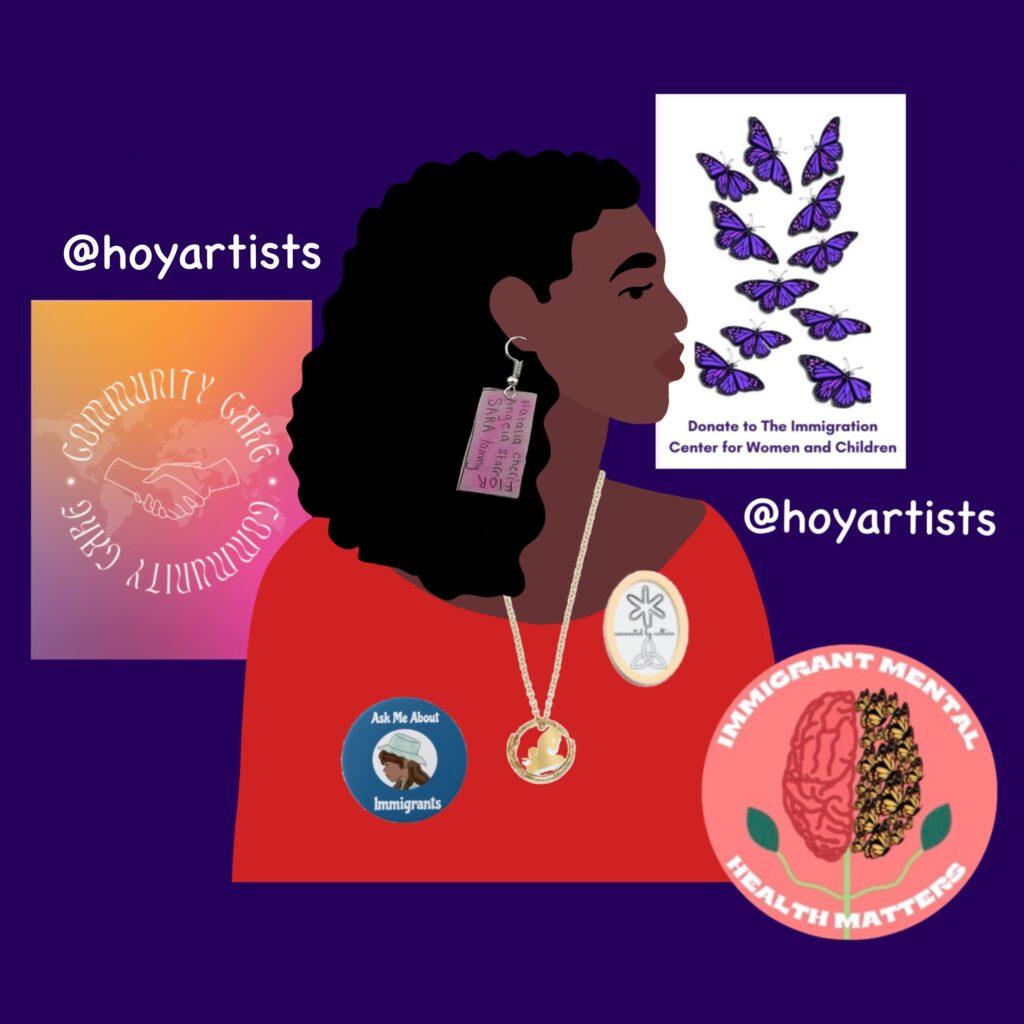From jewelry to tote bags and buttons, @hoyartists is empowering students to use art as activism.
In December 2021, justice and peace studies professor Kim Lubreski asked her students to each design a piece of artwork that centered around the stories and experiences of immigrants throughout the world. From illustrated tote bags to printed face masks, intricate henna designs to etched earrings, these students used their creative visions to educate others on the importance of immigrants’ stories. Now, these works have been memorialized for the world to see on the Instagram account @hoyartists and a digital magazine.
The project centered around conceptualizing what art means and how it can be used as a form of activism, Lubreski said.
“What we thought about is: what makes art? And who can make art? Art absolutely, historically, is a way to express activism,” Lubreski said to The Hoya.
To craft their ideas, Lubreski asked students to choose a published memoir about immigration-related issues, write up a description of the experiences in those books, and describe how their chosen story translated into the art piece they produced.
Each post on @hoyartists features an individual student’s artwork and description, showcasing the stories they chose to highlight for the world to see. While the account may no longer be posting since the class ended, the page still underscores the power art holds in telling stories.
Lubreski’s class, titled “Gender, Immigration and Social Justice,” focused on the intersection of those three topics. Students had the opportunity to engage with a variety of media and research in the class like ethnographies, oral histories and memoirs.
Whereas previous projects included more confining instructions, Lubreski said she sought to create a more open-ended final project to accommodate learning during the COVID-19 pandemic.
“Prior to the pandemic, I had students do a podcast where they interviewed someone from an immigrant community about their experiences,” Lubreski said. “But then with a pandemic, I realized that this really would not fit in well. I wanted to do something a little bit different and get students away from their screens. So I revamped the course last fall.”
The project’s mission statement, as seen on its Instagram page, is simple yet striking: “to educate ourselves and others about the diversity, power, and importance of immigrant stories through art and the creative process.”
Lubreski’s student Sophia Bos-Shadi (COL ’22) said the project’s mission statement helped students emphasize both their own identities and their commitment to service through academics.
“A lot of our more marginalized students come from communities that we are constantly bringing into the classroom and trying to uplift,” Bos-Shadi said in an interview with The Hoya. “I know in my life, everything is centered around service. I think this project, with everyone calling attention to issues and trying to generate material support, really exemplifies that.”
A lot of the artwork and student creations vary in media that showcase students’ individual talents in drawings and digital production. For instance, one of the projects is a beautifully intricate henna tattoo, while another project is mask designs that were created online.
The art compiled for @hoyartists holds a deep personal meaning for many of the students involved, according to Bos-Shadi.
“A lot of us are members of immigrant communities, and we’re responding to hardships that we had seen or experienced, or that people in our own lives had seen or experienced,” Bos-Shadi said.
Bos-Shadi’s project sought to raise awareness for violence against women within immigrant communities. Her piece featured purple butterflies arranged in a ribbon pattern, meant to evoke the image of the purple ribbon, a symbol designed to raise awareness for domestic violence. The design also implores the viewer to donate to the Immigration Center for Women and Children. She said her design is an adaptable piece of art that could be put on anything from bags to buttons to shirts in order to raise both money and awareness for the issue.
Ariel Barron (COL ’22), another student in the class, highlighted the importance and struggle of maintaining one’s cultural identity while adjusting to a new country in her final project entitled “Creating Community in the Diaspora.” Barron said her design had many symbolic aspects yet remained fun.
“The design itself had the symbol for connectedness, the symbol for diaspora, and things like that, but in the form of a cute little art piece that can symbolize all these things at once,” Barron said in an interview with The Hoya.
Barron’s work, a pendant featuring the words “connected by culture” in its center, was intended to highlight the interconnectedness of diasporic communities, even though they might be widely separated. Her description of the work on the page explains it is “worn close to the heart of those feeling further from their community.”
Bos-Shadi says she also chose her topic for personal reasons, as her art was informed by experiences in her childhood and with her family members.
“It is something that strikes really close to home for me, as I grew up as part of an immigrant community. My dad is an immigrant, and I grew up in rural America. The Arab immigrant community was like four families, and so I really experienced firsthand how if a woman was in a bad situation, they were so isolated from everyone else in our community,” Bos-Shadi said.
By using Instagram as the format for the final project, Lubreski’s class allowed students to engage with each other while giving them a platform to advocate for an issue they care about. The nature of this final allowed students to be creative, and Lubreski said that the individualized projects ended up reflecting the personal interests of her students.
“They created a framework that worked, a template that everyone would follow. But then within each page, it was very unique and different, reflecting the students’ particular interests,” Lubreski said. “In my many years of teaching, I’ve never experienced this.”



















